BodyMedia CR200 CORE Charger CR200 User Manual
BodyMedia, Inc. CORE Charger CR200
User Manual
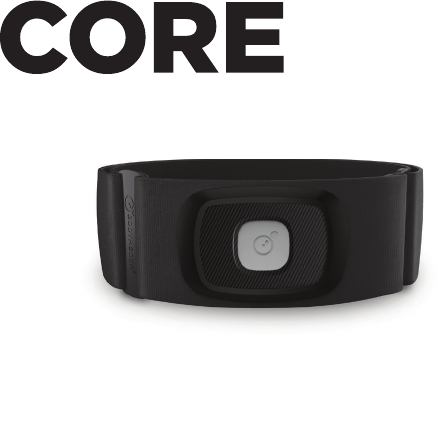
Visit up.jawbone.com
Get the app. Connect your armband.
Start living better.
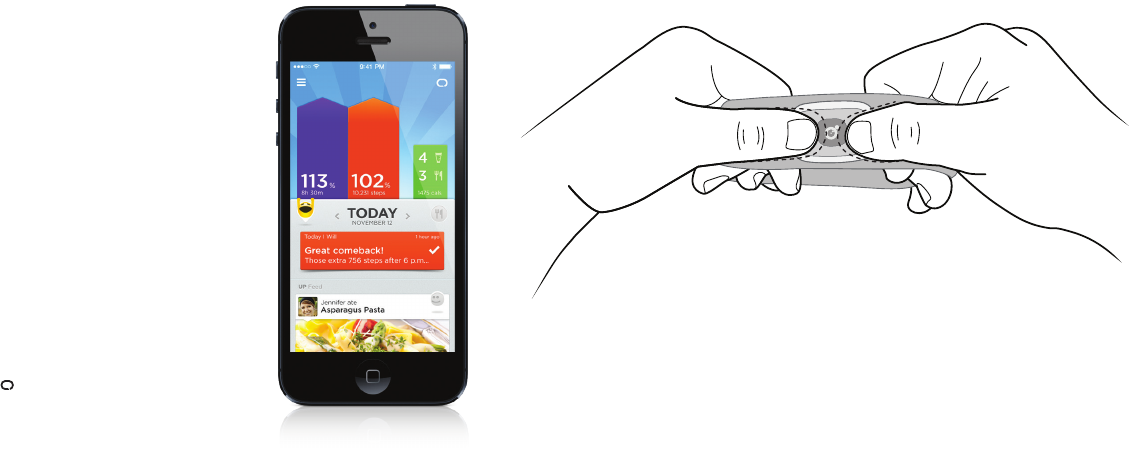
2 3
SENSOR MODULE
To remove the sensor module from the strap, press down evenly on both
sides of the front face of the sensor module until it comes out of the strap.
To reattach the sensor module, align the large indentation on the inside of
the strap with the tab on the sensor module. Press evenly on both sides
until the sensor module firmly snaps into place.
GET THE APP
Go to up.jawbone.com
Already using UP?
Make sure you have the latest version of the app.
CONNECT YOUR ARMBAND
Follow the instructions to pair your
armband and create your profile.
Already using UP?
Tap the icon in the top right corner of the home
screen, “Add new band” and follow the instructions.
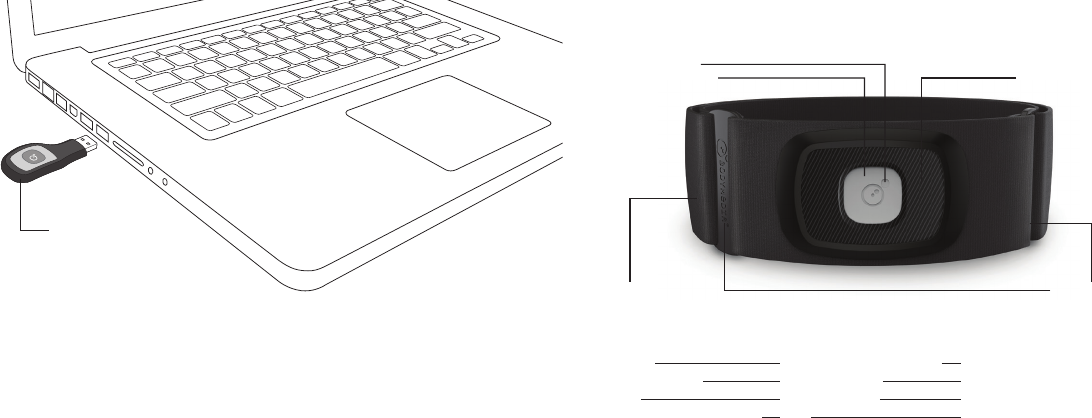
4 5
STATUS BUTTON
STRAP
SENSOR MODULE
ADJUSTERS
STATUS LIGHT
STATUS INDICATORS
Sound
3 Beeps
Single Alert tone
None
Alert tone every 15 seconds
Status Light
Solid Light for a few Seconds
Slow blinking light
Fast blinking light
None
Status
Armband Collecting Data*
Low Battery
Battery Depleted
Armband not configured to app
*It may take up to 10 minutes for the armband to
begin collecting data after it is placed on the arm.
KEEP YOUR ARMBAND CHARGED
Your armband should last at least four days when fully charged. The UP
app will notify you when the battery is low. To charge your armband,
remove the sensor module from the strap, place the sensor module into
the dock and plug it into a USB port.
The status light will flash two times when fully charged. This may take
up to two hours.
DOCK
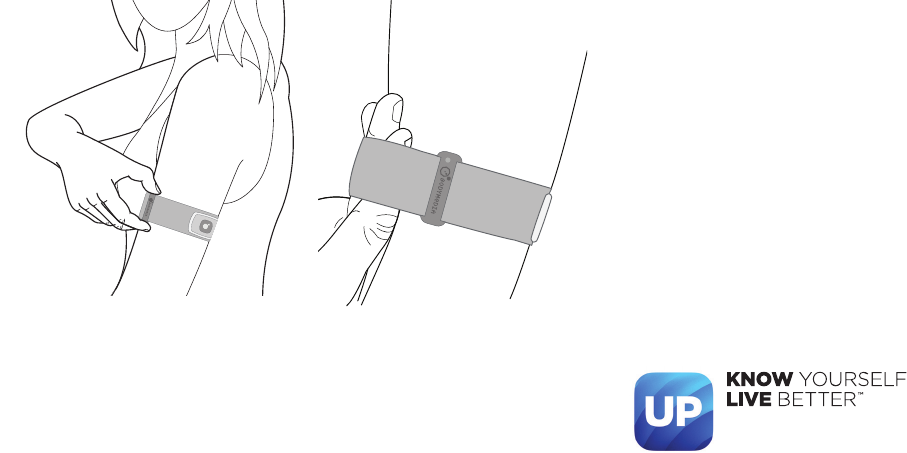
6 7
Questions? Support?
jawbone.com/support/core
HOW TO WEAR CORE
Wear on the back of your left tricep (your arm and CORE should be clean, dry,
and free of lotion or oil). Make sure the sensors touch your skin and the logo on
the button points up toward the right.
Use the adjusters to tighten and loosen the strap, before putting it on your arm.
Make sure the strap is not too tight—you should be able to place three fingers
beneath it. Once the strap is adjusted to a comfortable fit, there is no need to
readjust it. Simply slide the armband on and o your arm by stretching the strap.

8 98 9
WARNINGS
• Always consult a physician before starting any new diet or exercise program.
• This system (CORE device and UP app) is not to be used for diagnostic purposes and is not intended to be a substitute for
the medical advice or supervision of your personal physician.
• Because everyone’s skin is different you may experience irritation or redness after wearing the armband. If this
occurs, discontinue use and consult your physician.
• If you have known metal allergies, consult your physician prior to wearing.
• Do not wear on an open wound, sore, burn, blister or rash.
• To reduce potential for skin irritation, limit wearing the device to a maximum of 23 hours per day.
• To reduce the potential risk of skin irritation, dry your arm and the armband thoroughly before wearing.
• To avoid skin burns, do not wear when it has been exposed to excessively hot temperatures including direct sun exposure.
• Choking hazard. This product contains small parts. Keep out of the reach of children under 3 years.
• Be careful not to over-tighten the strap while on your arm. If you feel constriction or loss of circulation at any time,
loosen the adjustable strap and readjust it to a more comfortable setting. If you experience pain, bruising, swelling, or
discoloration of the arm, discontinue use and consult a physician.
CAUTIONS
• Check CORE for sharp edges or damage before each use.
• The armband and dock should not be used in airplanes, hospitals, or any location that prohibits cellular telephones
or electronic devices.
• Do not place the CORE in close proximity to other devices that can cause electromagnetic interferences of any
nature.
• Do not incinerate.
• Rough handling can break internal components.
• Never drop or shock the armband and dock and always store it in a safe and dry place when not in use.
• If the armband is dropped, ensure that it is working properly and not physically damaged before relying on readings.
• Do not attempt to open the armband or dock yourself. It contains no user-serviceable parts. Refer all servicing to
qualified Service Personnel. Opening the armband or dock yourself will void the warranty.
• Do not use unapproved accessories.
• This product is not defibrillation proof.
• The equipment is not suitable for use in the presence of a flammable anesthetic mixture with air or with oxygen or
nitrous oxide.
• Medical electrical equipment requires special precautions regarding electromagnetic environments (EMC) and must
be installed and put into service according to the EMC information provided in the User Manual. Portable and mobile
radio frequency (RF) communications equipment can affect medical electrical equipment.
• The equipment of the system should not be used adjacent to or stacked with other equipment.
• Avoid exposing the equipment to extreme temperatures like saunas, direct sunlight, moisture, sand, dust, leaving in
freezing conditions, or mechanical shock.
• All references to the equipment have been replaced by the product name, CORE.
ACCESSORIES
• Additional strap sizes and accessories available at jawbone.com/core
CORE CARE
Clean the armband regularly after sweating or when it becomes noticeably moist or dirty. Failure to keep the armband
clean, or improper cleaning may irritate the skin and affect the sensor performance. Minimize use of solvents, cleaners
or other chemicals and do not sterilize any part(s).
• To clean the sensor module, use a cloth or towel moistened with mild soap and water to wipe the metal sensors that
touch the skin. Remove any excess soap and dry with a cloth or towel completely before wearing.
• To clean the strap, hand wash with mild soap and warm water, rinse, then air dry. For optimal performance and
lifespan of the strap, avoid machine drying.
• The sensors may be disinfected by wiping with a soft cloth dampened with 70% isopropyl alcohol. Allow 5-10 minutes
for drying before wearing. Always disinfect the sensor module and replace the armband strap prior to use by others.
• Though the armband was designed for wearability and long-term use, it is a sensitive monitoring device. Rough
handling can break internal components.
SAFE DISPOSAL
Dispose of the CORE armband, battery, and this packaging in accordance with local regulations. Do not dispose of the
battery in the sensor module with regular household waste.
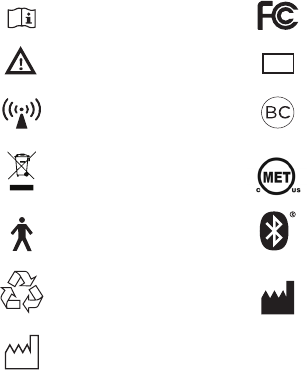
10 11
SN
10 11
SYMBOL DEFINITIONS
Consult instructions for use FCC Declaration of Conformity
Non-ionizing radiation Battery Charger System Compliance
Type B Applied Part Bluetooth® Wireless Technology
Date of Manufacture
Manufacturer
CAUTION Serial Number
The Waste Electrical and Electronic
Equipment Regulations indicates
separate collection for electrical and
electronic equipment
Electrical Safety
Armband tested to applicable safety
standards by MET Laboratories
Recyclable
SYSTEM ACCURACY (PER DAY, ADULTS)
• Total calories/METs for free living activities: mean error < 10%
• Total minutes of physical activity: mean error < 5%
• Total step count: mean error < 9%
PRODUCT SPECIFICATIONS
SENSORS
• Accelerometer (3-axis)
• Heat Flux
• Skin Temperature
• Galvanic Skin Response (GSR)
MATERIALS
• Sensor Module: PC/PBT, thermoplastic urethane, 316L grade stainless steel
• Adjustable strap/wing assembly: Nylon, elastane, silicone, 316L stainless steel, PC/PBT and rubber coating
Battery power: At least 4 days
Battery type: Internal lithium polymer cell
Radio Frequency: 2.4GHz
Contains a class 2 Bluetooth wireless technology transceiver
Transmitter output power: <2.5mW
Sensor Module size: (l) 26mm x (w) 36mm x (h) 13mm [1.0” x 1.4” x 0.5”]
Armband weight (with adjustable strap): 30g (1.1oz)
Water resistance: IPX5 classified
Operating temperature/humidity: +5°C - 40°C (40°F to 104°F)/ 5 - 95% RH non-condensing
Storage temperature/humidity: -20°C - 55°C (-4°F to 131°F) / 5 - 95% RH non-condensing

12 1312 13
USER ENVIRONMENT
1.5m 1.5m
2.5m
1.5m
Computer and Wireless
Communicator
Diagram not to scale.
GUIDANCE AND MANUFACTURER’S DECLARATION - EMISSIONS
The Armband is intended for use in the electromagnetic environment specified below. The customer or user
of the Armband should ensure that it is used in such an environment.
EMISSIONS TEST
RF Emissions CISPR 11
Harmonics IEC 6100-3-2
Flicker IEC 6100-3-3
COMPLIANCE
Class B, Group 1
N/A
N/A
ELECTROMAGNETIC ENVIRONMENT–GUIDANCE
The Armband uses RF energy only for its internal
function. Therefore, its RF emissions are very low
and are not likely to cause any interference in nearby
electronic equipment
The Armband is suitable for use in all establishments,
including domestic, and those directly connected to
the public low-voltage power supply network that
supplies buildings used for domestic purposes
GUIDANCE AND MANUFACTURER’S DECLARATION - IMMUNITY
The Armband is intended for use in the electromagnetic environment specified below. The customer or user
of the Armband should ensure that it is used in such an environment.
IMMUNITY TEST
ESD IEC 61000-4-2
EFT IEC 61000-4-4
Voltage Dips/
Dropout IEC
61000-4-11
Power Frequency
50/60H
Magnetic Field IEC
61000-4-8
IEC 60601
TEST LEVEL
COMPLIANCE
LEVEL
±6kV Contact
±8kV Air
±2kV Mains
±1kV I/Os
±1kV Differential
±2kV Common
>95% Dip for
0.5 Cycles
60% Dip for 5
Cycles
30% Dip for 25
Cycles
>95% Dip for 5
Seconds
3A/m
±6kV Contact
±8kV Air
N/A
N/A
N/A
3A/m
ELECTROMAGNETIC ENVIRONMENT–GUIDANCE
Floors should be wood, concrete, or ceramic tile. If
floors are synthetic, they r/h should be at least 30%
Mains power quality should be that of a typical
commercial or hospital environment
Mains power quality should be that of a typical
commercial or hospital environment. If the user of the
Armband requires continued operation during power
mains interruptions, it is recommended that the
Armband be powered from an uninterruptible power
supply or battery.
Power frequency magnetic fields should be that of a
typical commercial or hospital environment.

14 1514 15
GUIDANCE AND MANUFACTURER’S DECLARATION - EMISSIONS
The Armband is intended for use in the electromagnetic environment specified below. The customer or user
of the Armband should ensure that it is used in such an environment.
IMMUNITY TEST
Conducted RF
IEC 61000-4-6
Radiated RF
IEC 61000-4-3
IEC 60601
TEST LEVEL
COMPLIANCE
LEVEL
3 Vrms
150 kHz to
80 MHz
3 V/m
80 MHz to
2.5 GHz
3 Vrms
150 kHz to
80 MHz
3 V/m
80 MHz to
2.5 GHz
ELECTROMAGNETIC ENVIRONMENT–GUIDANCE
Portable and mobile communications equipment
should be separated from Armband by no less than
the distances calculated/listed below:
D=(3.5/V1)(Sqrt P)
D=(3.5/E1)(Sqrt P) 80 to
800 MHz
D=(7/EI)(Sqrt P)
800 MHz to 2.5 GHz
Where P is the max power in watts and D is the
recommended separation distance in meters.
Field strengths from fixed transmitters, as determined
by an electromagnetic site survey, should be less than
the compliance levels (V1 and E1).
Interference may occur in the vicinity of equipment
containing a transmitter.
RECOMMENDED SEPARATION DISTANCES FOR THE PRODUCT
The Armband is intended for use in the electromagnetic environment specified below. The customer or user
of the Armband can help prevent electromagnetic interference by maintaining a minimum distance between
portable and mobile RF Communications Equipment and the Armband as recommended below, according to
the maximum output power of the communications equipment.
MAX OUTPUT POWER
(WATT S)
SEPARATION (M) 150KHZ
TO 80MHZ
D=(3.5/V1)(SQRT P)
SEPARATION (M) 80 TO
800MHZ
D=(3.5/V1)(SQRT P)
SEPARATION (M) 800MHZ
TO 2.5GHZ
D=(7/E1)(SQRT P)
0.01
0.1
1
10
100
0.1166
0.3689
1.1666
3.6893
11.6666
0.1166
0.3689
1.1666
3.6893
11.6666
0.2333
0.7378
2.3333
7.37 8 6
23.3333

16 1716 17
REGULATORY STATEMENT
FCC Declaration of Conformity – We, BodyMedia, Inc., One Gateway Center, 420 Fort Duquesne Boulevard, Suite 1900,
Pittsburgh, PA 15222, a wholly owned subsidiary of Jawbone, declare under our sole responsibility that the products,
BodyMedia, Inc. and BodyMedia® Armband (Model AB200) and Dock (Model CR200), comply with part 15 of the FCC
rules. Operation is subject to the following two conditions: (1) This device may not cause harmful interference, and (2)
This device must accept any interference received, including interference that may cause undesired operation.
This equipment has been tested and found to comply with the limits for a Class B digital device, pursuant to part 15 of
the FCC Rules. These limits are designed to provide reasonable protection against harmful interference in a residential
installation. This equipment generates, uses and can radiate radio frequency energy and, if not installed and used
in accordance with the instructions, may cause harmful interference to radio communications. However, there is no
guarantee that interference will not occur in a particular installation. If this equipment does cause harmful interference
to radio or television reception, which can be determined by turning the equipment off and on, the user is encouraged
to try to correct the interference by one or more of the following measures:
• Reorient or relocate the receiving antenna.
• Increase the separation between the equipment and receiver.
• Connect the equipment into an outlet on a circuit separate from the receiver.
• Consult the dealer or an experienced radio/TV technician for help.
CAUTION: Changes or modifications to this equipment not expressly approved by the party responsible for
compliance could void the user’s authority to operate the equipment.
RF Exposure information: See 2.1093 of the FCC Rules
This product is a Type B Applied Part complying with the specified requirements of the Standard to provide protection
against electric shock, particularly regarding allowable Leakage Current.
IEC 60601-1, Edition 3.1, 2012-08, Medical Electrical Equipment - Part 1: General requirements for basic safety and
essential performance
IEC 60601-1-2, Third Edition, 2007-03, Medical Electrical Equipment - Part 1-2: General requirements for basic safety
and essential performance - Collateral standard: Electromagnetic compatibility - Requirements and tests
AAMI60601-1: ANSI/AAMI ES60601-1:2005, Medical Electrical Equipment – Part 1: General Requirements for Basic
Safety and Essential Performance
ANSI/IEC 60529, 2004, Degrees of Protection Provided by Enclosures (IP Code)
IEC 60950-1, Edition 2.1, 2012-05, Information Technology Equipment - Safety - Part 1: General Requirements
UL 1642, Standard for Safety, Lithium Batteries
IEC 62133, Edition 2.0, 2012, Secondary cells and batteries containing alkaline or other non-acid electrolytes - Safety
requirements for portable sealed secondary cells, and for batteries made from them, for use in portable applications
WEEE, 2006 No. 3289, Environmental Protection - The Waste Electrical and Electronic Equipment Regulations
California Energy Commission - 2012 Appliance Efficiency Regulations, CEC-400-2012-019-CMF
47CFR Part 15 Subpart B & ICES-003, Issue 4 February 2004 for Class B Digital Devices
47CFR Part 15 Subpart C 15. 247 & RSS-210, Issue 8, December 2010 for Intentional Radiators
ETSI EN 300 328 (Article 3.2 of R&TTE Directive)
ETSI EN 301 489-1 with ETSI EN 489-17 (Article 3.1(b) of R&TTE Directive)
RoHS requirements
BodyMedia, Inc.
One Gateway Center
420 Fort Duquesne Blvd.
Suite 1900
Pittsburgh, PA 15222
USA 100891_Rev1

QUESTIONS? SUPPORT?
JAWBONE.COM/SUPPORT/CORE
CORE